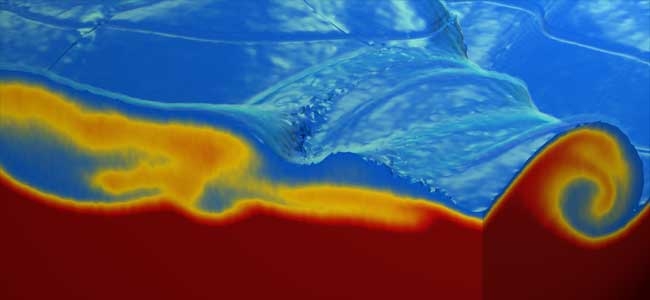Lawrence Livermore National Laboratory opens High Performance Computing Innovation Center for collaboration with industry
 (Download Image)
A visualization of waves generated at the interface of two dissimilar moving fluids, modeled with atomic-level resolution at Lawrence Livermore National Laboratory. Roughly 63 billion atoms were simulated on a supercomputer with more than 200,000 processors to analyze a physical phenomenon as familiar to us as the effects of wind blowing over a body of water.
(Download Image)
A visualization of waves generated at the interface of two dissimilar moving fluids, modeled with atomic-level resolution at Lawrence Livermore National Laboratory. Roughly 63 billion atoms were simulated on a supercomputer with more than 200,000 processors to analyze a physical phenomenon as familiar to us as the effects of wind blowing over a body of water.
In an initiative that aims to boost the nation's economic competitiveness, Lawrence Livermore National Laboratory today announced the opening of the High Performance Computing Innovation Center (HPCIC).
The innovation center will facilitate national lab/industry collaboration, applying high performance computing to product design, development and manufacturing, data management and the operation of complex energy and communication systems. Industries expected to benefit from the use of HPC range from aerospace, automotive and transportation to utilities, energy, health care, finance, materials manufacturing, nanotechnology and consumer electronics.
The innovation center was opened in a ribbon cutting ceremony attended by local Congressional Representatives John Garamendi and Jerry McNerney as well as other local officials.
"The high performance computing innovation center opens a new era in Lawrence Livermore's collaboration with universities and industry," said LLNL Director George Miller. "We have a long history of mutually beneficial partnerships. These efforts will expand with the innovation center, which will create even greater opportunities for collaboration with corporate and academic partners to meet the nation's important challenges through advances in science and technology."
"Making LLNL's unique computing capabilities and expertise in science and engineering available to the private sector will help U.S. industry compete in the global economy and benefit national security," said Alice Williams, manager of NNSA's Livermore Site Office. "Broadened collaboration with industry will allow the Lab to develop expertise in new areas that will help the National Nuclear Security Administration fulfill its missions in such domains as national, economic and energy security."
The HPC Innovation Center (HPCIC) makes available to industry more than two decades of experience as a global leader in supercomputing. To fulfill its primary mission to ensure the safety, security and reliability of the nation's aging nuclear deterrent without testing, LLNL, in partnership with IBM, has developed and deployed some of the fastest supercomputers, including BlueGene/L, which held the No. 1 ranking on the industry-standard Top500 list of the world's most powerful computers for nearly four years. Through HPCIC, industry will now be able to tap Laboratory capabilities and expertise that have allowed the United States to end nuclear testing and greatly advanced the state of related science.
LLNL offers expertise in every aspect of the management of an HPC center, including storage, analysis and visualization. As a multidisciplinary applied science laboratory, LLNL also has available scientists and engineers with extensive experience applying HPC to a broad set of technical problems in fields such as materials science, micro and nanotechnology, bioscience and energy, notably fusion energy.
The HPCIC also will allow multi-partner collaboration that could include other government agencies, research institutions and academia. To learn more about the benefits of HPC or to arrange a briefing, visit the Livermore Valley Open Campus Website.
The innovation center being opened today represents the first step in the creation of a collaboration zone, called the open campus, being developed on the Livermore Lab's east side.
LLNL's Fred Streitz, an award-winning computational physicist, will serve as the HPCIC director. Streitz has twice led teams awarded the prestigious Gordon Bell Prize for groundbreaking simulations that have provided scientific insight and advanced high performance computing. He also is director of LLNL's Institute for Scientific Computing Research.
Contact
Donald B Johnston[email protected]
925-423-4902
Related Links
Advanced Simulation and ComputingComputing resources
Featured science
Tags
User FacilityHPC, Simulation, and Data Science
Computing
Engineering
Physical and Life Sciences
HPC Innovation Center
Energy
Science
Featured Articles







